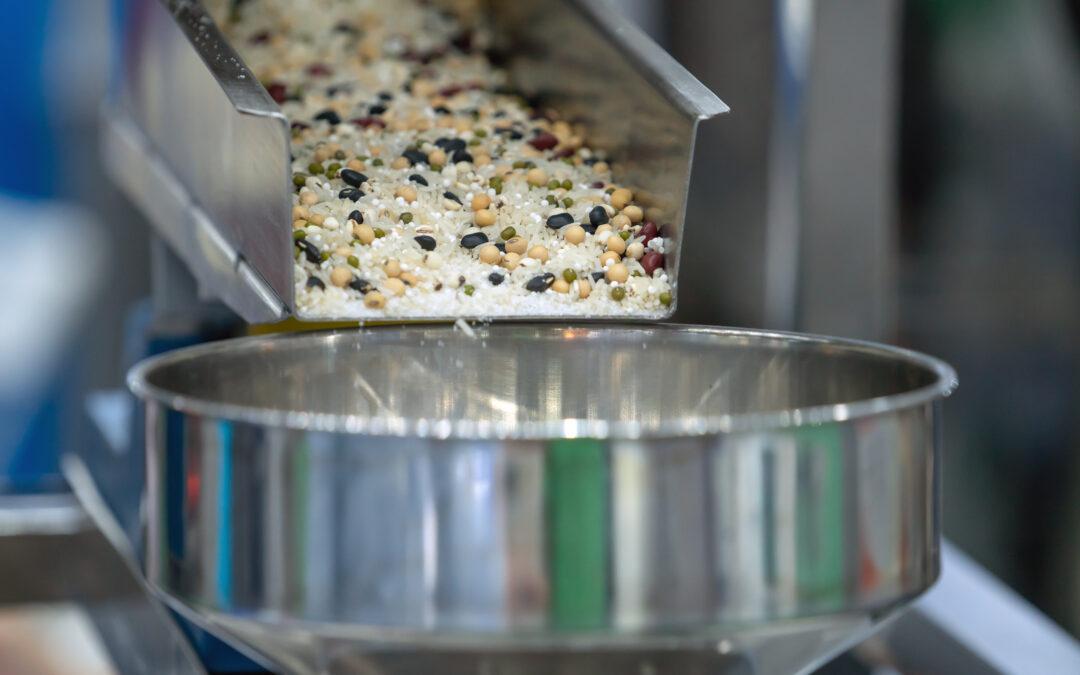What is a vibrating conveyor?
Vibrating conveyors are made up of troughs or tubes that are supported in a flexible way and vibrated by mechanical or electrical means to move objects or bulk materials. The vibrations move in an elliptical, slanted pattern to move the material in a certain direction as well as up.
Vibrating Conveyors use vibrational energy to impart static and dynamic forces on aggregate materials and cause them to move up or down a pathway. In most cases, a smooth trough serves as the conveying surface, and vibratory components are affixed along its length to cause the trough to shake. Bulk goods like coal, limestone, food products, sand, gravel, and other similar items can “bounce” with the frequency of the vibration to one end of the trough. This hopping action, repeated many times per second, allows the bed of materials to convey and can even drive deep beds of bulk. When transporting on a horizontal plane or a shallow slope is required, vibrating conveyors are often the preferred choice because of their versatility in handling a wide variety of bulk materials.
How do Vibrating Conveyors work?
It will be difficult to generalize the working principles of all vibrating conveyors because their function is greatly reliant on their motor and its design. In typical vibrating equipment, the trough is subjected to an oscillating force imparted by the driving system at a predetermined frequency and amplitude. As a general rule, the trough stroke, or one complete movement of the trough, is twice the amplitude of the vibration, and most vibrating conveyors aim to lower the amplitude while increasing the frequency. Since the frequency and amplitude of these vibrating conveyors can be adjusted precisely, they are often referred to as “controlled” conveyors. In order to reduce energy consumption and ensure that the vibration is distributed evenly throughout the trough, natural frequency vibrating conveyors use springs and other components to induce the trough to vibrate at its intrinsic frequencies. Natural frequency approaches are used by the vast majority of vibrating conveyors, however regulated conveyors are usually somewhat specialized. Because different materials (and even different batches of the same material) react differently to the amplitude and frequency of the conveyor, designing a suitable conveyor requires extensive mathematical analysis.
Cranks and springs, rotating weights, and electromagnets are the three most common types of drive systems in vibrating conveyors. As seen in the diagram. A crank or spring-type conveyor is that in which a four-bar mechanism is turned by a motor to apply an elastic force that creates sinusoidal motion. The same result can be achieved by rotating weights or electromagnets, but they achieve this by rotating eccentric weights or magnetic fields, respectively. All drive systems have been demonstrated to be effective, and the benefits of one over another vary widely depending on the specifics of the application of the vibrating equipment and the working environment.
Vibrating Conveyor USES
The vibrating conveyor has many uses in food and chemical, rubber, foundry, processing, and other industries where safety and cleanliness are of the utmost importance. They function well in polluted, hot, and corrosive environments.
Additionally, they are naturally self-cleaning, which means they won’t contaminate when transported delicate products like potato chips. There is no risk of them being left alone, and they are easy to make. Vertical and horizontal height are the only constraints on what can be transported by a vibrating conveyor.
TYPES OF VIBRATING CONVEYORS
- Standard duty vibrating conveyors
- Heavy-duty vibrating conveyors
- Vibratory Feeders
- Oscillating Conveyors
Classifying vibrating conveyors is difficult because there aren’t really any distinct subclassifications of this conveyor; instead, they are typically grouped together based on their eventual use or duty type. To add more confusion, manufacturers often assign certain functions or designs to their vibrating conveyors. The purpose of this article is to provide examples of the most common kinds of vibrating conveyors so that the reader can see what kinds of vibrating conveyors are commercially available to them.
Standard duty vibrating conveyors
Materials of medium to low density, such plastics, wood, and porous rock, are ideal for standard duty vibrating conveyors. Capabilities can range from 1 to 40 tons per hour, and they can travel at speeds of up to 60 feet per minute. Due to their durability and low maintenance requirements, these conveyors provide a safe and dependable means of transporting material. They have many different applications, including in the food and chemical industries, in industry, and in plastics.
Heavy-duty vibrating conveyors
Typically used for rock, metal, and big numbers of heavy products, heavy-duty vibrating conveyors are certified to transport heavier, more ungainly commodities that demand great power and speed. They are commonly installed devices that demand for particular foundation supports including dampers, dashpots, stands, and more; their capacities surpass 500 tons per hour at speeds up to 90 feet per minute. Heavy-duty conveyors, unlike light-duty vibrating conveyors, typically require motors for control and thus more power. They have numerous industrial uses, including in foundries, large-scale production, the lumber and rubber industries, and more.
Vibratory Feeders
Vibratory feeders are a special kind of vibrating equipment that are used to feed materials into another machine in a controlled and consistent manner, setting them apart from other forms of vibrating conveyors. These feeder conveyors shine in continuous weighing applications with strict capacity requirements that preclude the use of other feeder types. Vibratory feeders are employed in a bowl configuration to reliably transport small, irregularly shaped parts like screws, rings, and others. They serve a wide variety of purposes in the petrochemical, food, hardware, and industrial production sectors.
Oscillating Conveyors
The word “oscillating conveyor” appears sometimes among various manufacturers. Some people classify oscillating conveyors as a subset of vibrating conveyors due to the similarities between their operation and that of a conveyor equipment, but with a lower frequency and a greater amplitude of motion. Oscillating conveyors are used to move large quantities of commodities in industries including the lumber industry and trash management/recycling. Conveyor equipment can be used to move materials from one location to another; for instance, wood scraps could be moved from an upstream system to a discharge location. When comparing oscillating conveyors to vibrating conveyors, it is clear that the latter is more harsh on the material being moved. Jump conveyors is another name for oscillating conveyors used in the quarrying industry, whereas grasshopper conveyors is the more common name for them in hard rock mining.
Although some conveyor manufacturers and vendors do distinguish between oscillating and vibrating conveyors, be aware that some do not. There seems to be no consensus on the definitions or distinctions between these two names.
WHAT ARE ITS SPECIFICATIONS AND SELECTION CRITERIA
Vibrating conveyor equipment, as was previously explained, has a wide variety of machines and uses. The sheer number of possible configurations and alternatives presents a challenge when trying to settle on a final design. A decent magnetic conveyor option can be made with the use of the specifications provided in this article, which can be taken to most vendors.
Load capacity & pieces per minute
In order to determine the desired load capacity and pieces per minute, it is necessary to have a firm grasp on what will be transported by the magnetic conveyor, how much of it must be transported, and at what pace. Your conveyor provider will be able to get a decent notion of size, shape, and duty rating from these numbers. Your vendor should be able to advise you on the optimal capacity and speed for your project.
Trough length and vibrational frequency
Find out how far the aggregate has to travel, how broad it should be, and how much vibration will be required to move the material on the vibrating equipment. A broader trough and a larger drive, for instance, would be necessary if boulders were being transported across a considerable distance. The type of vibrating conveyor that will work best for your application can be determined together with the appropriate drive and power specifications using this information.
Control & special considerations
While these conveyors are normally low-maintenance and passive, they can be controlled if they are incorporated into a larger control system. If command is unnecessary, numerous low-effort strategies exist. Find out if there are any additional specifications, such as safety barriers, confinement, sterile materials, or damping of the foundation. You should provide your supplier with these factors and any others that are particularly relevant so that they may assist you narrow down your alternatives.
VIBRATING CONVEYOR BENEFITS AND FEATURES
- Units of vibrating conveyors can be as long as 400 feet and as wide as 6 inches.
- For applications with limited ceiling height, light and medium-duty vibrating conveyor systems are available, each with a leaf spring design.
- In order to withstand the rigorous conditions of heavy-duty applications, vibrating conveyor designs use a sturdy coil spring architecture and rocker arm stabilizers.
- Careful handling is required for fragile items.
- There are high-temperature conveyors that can move items up to 2000 degrees Fahrenheit.
- The low-stress, long-lasting construction uses a natural frequency.
- The conveyor’s structural basis is made entirely of steel the whole way along.
- Minimal wear and tear thanks to few moving components and smooth design.
- Reduced responses make mounting in the top structure possible for balanced/isolated units.
- Trough polishing and adhesive-specific coatings are both options.
- Liner and worn surfaces are readily available for replacement.
- Simple to disinfect and sanitary, you can choose between 3A dairy designs and CIP systems.
- Safe and comfortable dust-proof construction is provided.
- Gates can be opened manually or automatically.
- Spills are never an issue because of the leak-proof troughs.
- Super quiet, cheap to run, and efficient in terms of both money and energy usage.
SUMMING UP!
Conveying, drying, cooling, scalping, screening, quenching, dewatering, orienting, accumulating, separating, and dispersing are just some of the many tasks that our vibrating conveyor equipment can perform. Carrier conveyors are dependable and simple to maintain, and they may be customized to fit your specific requirements.
If you’re looking for conveyor equipment manufacturers, look no further than DPH Engineering! To process a wide range of bulk materials, DPH Engineering has developed mechanical feeders that are both easy to use and extremely durable. Conveyors can have either one or two vibrating masses, which are agitated by an eccentric shaft powered by an electric motor. The characteristics of springs shift depending on their intended function.
These conveyors are unique for their small, straight-line construction, which gives them a very low profile and makes them simple to service. There must be at least some spare space above the ceiling.
For more information, contact us!

